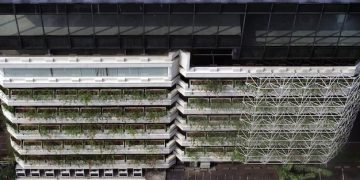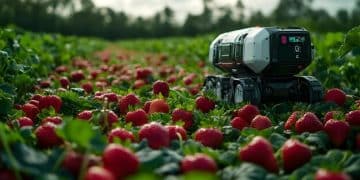Smart Greenhouses: Boost Yields & Quality with Optimized Control
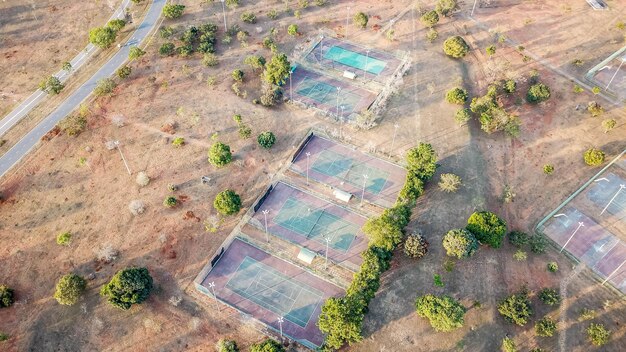
Smart greenhouses revolutionize agriculture by using advanced environmental control to optimize growing conditions, leading to higher yields and better quality crops.
Discover how smart greenhouses are transforming agriculture by optimizing environmental control for superior crop yields and quality, revolutionizing the way we grow food.
Understanding Smart Greenhouses and Their Benefits
Smart greenhouses represent a significant leap forward in agricultural technology. By integrating environmental sensors, automated control systems, and data analytics, these structures create optimal growing conditions for plants, regardless of external weather patterns.
The primary goal of a smart greenhouse is to maximize yield and quality while minimizing resource consumption. This is achieved through precise control over factors like temperature, humidity, light, and CO2 levels, all tailored to the specific needs of the crops being grown.
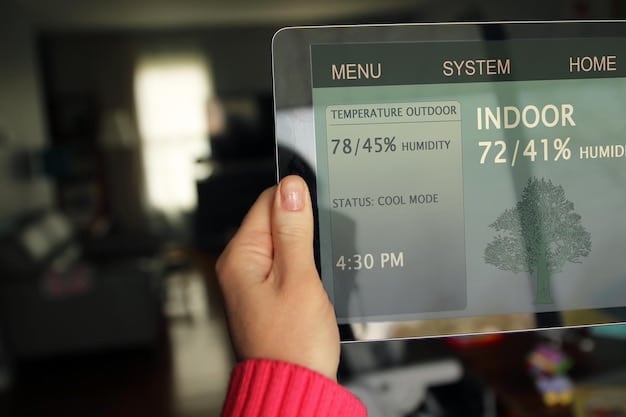
Key Advantages of Smart Greenhouses
Smart greenhouses offer a range of advantages over traditional growing methods. These benefits extend from increased productivity to improved sustainability.
- Higher Yields: Optimized growing conditions lead to significant increases in crop production compared to traditional greenhouses or open-field farming.
- Improved Quality: Precise environmental control results in consistently high-quality produce with enhanced nutritional value and flavor.
- Resource Efficiency: Smart greenhouses minimize water and energy consumption through automated irrigation and climate control systems.
- Reduced Labor Costs: Automation reduces the need for manual labor, lowering operational expenses.
In conclusion, smart greenhouses offer a compelling solution for modern agriculture, providing a path towards sustainable and efficient food production. The ability to precisely control the growing environment unlocks new possibilities for crop optimization.
Environmental Control Systems in Smart Greenhouses
At the heart of every smart greenhouse is a sophisticated environmental control system. These systems are designed to monitor and adjust various environmental parameters to create the ideal growing environment.
These control systems use a combination of sensors, actuators, and software algorithms to maintain stable and optimized conditions. This ensures that crops receive the precise resources they need to thrive.
Components of Environmental Control Systems
The environmental control system contains several key components that work together to create an optimal growing environment.
- Sensors: These devices measure environmental parameters such as temperature, humidity, light intensity, CO2 levels, and soil moisture.
- Actuators: These are mechanical or electrical devices that respond to signals from the control system to adjust environmental conditions. Examples include ventilation fans, heaters, cooling systems, and irrigation pumps.
- Control Algorithms: These are software programs that analyze sensor data and determine the appropriate actions for the actuators to take.
Effective environmental control is crucial for maximizing the productivity of a smart greenhouse. These systems must be designed to respond quickly and accurately to changes in the growing environment.
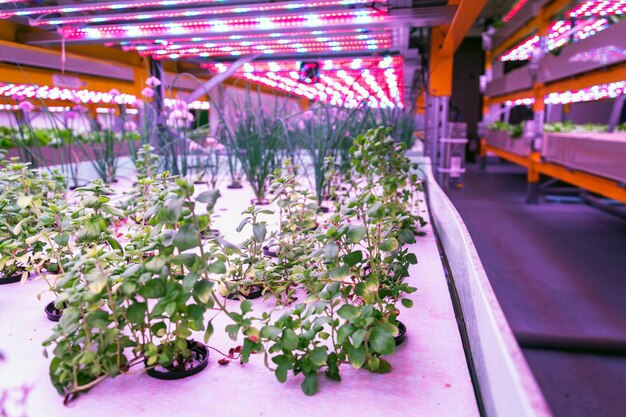
Optimizing Temperature and Humidity
Temperature and humidity are two of the most critical factors affecting plant growth. Maintaining optimal levels of these parameters is essential for maximizing yield and quality in a smart greenhouse.
Advanced climate control systems are used to automate the regulation of temperature and humidity within the greenhouse. These systems are designed to respond to both internal and external conditions.
Strategies for Temperature and Humidity Control
There are several strategies that can be used to optimize temperature and humidity levels in a smart greenhouse.
- Ventilation: Proper ventilation helps to remove excess heat and humidity, preventing the buildup of moisture and reducing the risk of disease.
- Heating and Cooling Systems: Heaters and coolers are used to maintain stable temperatures, especially during periods of extreme heat or cold.
- Humidification and Dehumidification: Humidifiers and dehumidifiers are used to regulate humidity levels, preventing conditions that are either too dry or too humid.
By using these strategies, growers can ensure that plants are always growing in the most favorable conditions, regardless of external weather patterns.
Managing Light and CO2 Levels
Light and CO2 are essential for photosynthesis, the process by which plants convert light energy into chemical energy. Managing these factors is crucial for maximizing plant growth and productivity.
Smart greenhouses use a variety of technologies to optimize light and CO2 levels. These technologies include supplemental lighting, shading systems, and CO2 enrichment.
Techniques for Light and CO2 Optimization
Several techniques can be used to optimize light and CO2 levels in a smart greenhouse.
- Supplemental Lighting: LED grow lights are used to supplement natural light, ensuring that plants receive adequate light energy, especially during periods of low sunlight.
- Shading Systems: Shading systems are used to reduce light intensity during periods of extreme sunlight, preventing overheating and damage to plants.
- CO2 Enrichment: CO2 enrichment involves increasing the CO2 concentration inside the greenhouse, boosting photosynthesis and increasing plant growth.
Proper management of light and CO2 levels can significantly enhance plant growth and productivity. This is particularly important for crops that require high light intensities or CO2 concentrations.
Irrigation and Nutrient Delivery Systems
Efficient irrigation and nutrient delivery are essential for maximizing plant growth and health. Smart greenhouses use advanced systems to deliver water and nutrients directly to the roots of plants.
These systems are designed to minimize water waste and ensure that plants receive the precise nutrients they need. This leads to healthier plants and higher yields.
Types of Irrigation and Nutrient Delivery Systems
Several types of irrigation and nutrient delivery systems are used in smart greenhouses.
- Drip Irrigation: Drip irrigation delivers water and nutrients directly to the roots of plants, minimizing water waste and reducing the risk of disease.
- Nutrient Film Technique (NFT): NFT involves growing plants in a shallow stream of nutrient-rich water, providing a constant supply of nutrients and oxygen to the roots.
- Aeroponics: Aeroponics involves growing plants in an air or mist environment, with the roots suspended in air and sprayed with nutrient-rich water.
By using these advanced systems, growers can achieve optimal plant growth and health while minimizing resource consumption. This contributes to the overall sustainability of the smart greenhouse.
Data Analytics and Automation
Data analytics and automation are central to the operation of smart greenhouses. These technologies enable growers to make informed decisions based on real-time data, optimizing growing conditions and maximizing efficiency.
Sensors throughout the greenhouse collect data on environmental conditions, plant growth, and resource consumption. This data is then analyzed using sophisticated software algorithms to identify trends and patterns.
Benefits of Data Analytics and Automation
Data analytics and automation offer several key benefits for smart greenhouse operators.
- Improved Decision Making: Real-time data and analytics provide growers with insights into plant health, environmental conditions, and resource consumption, enabling them to make informed decisions.
- Automated Control: Automation systems can automatically adjust environmental conditions based on sensor data and control algorithms, reducing the need for manual intervention.
- Predictive Analytics: Predictive analytics can be used to forecast future growing conditions and optimize resource allocation, preventing problems before they occur.
By leveraging data analytics and automation, growers can optimize the operation of their smart greenhouses, maximizing yield, quality, and efficiency.
The Future of Smart Greenhouses
Smart greenhouses are poised to play an increasingly important role in the future of agriculture. As technology continues to advance, these structures will become even more efficient and sustainable.
Innovations such as artificial intelligence, machine learning, and advanced robotics are expected to further enhance the capabilities of smart greenhouses, enabling growers to produce more food with fewer resources.
Emerging Trends in Smart Greenhouses
Several emerging trends are shaping the future of smart greenhouses.
- AI-Powered Automation: Artificial intelligence and machine learning are being used to develop more advanced automation systems that can learn from data and adapt to changing conditions.
- Vertical Farming: Vertical farming involves growing crops in vertically stacked layers, maximizing space utilization and increasing yields in urban environments.
- Sustainable Energy: Smart greenhouses are increasingly incorporating renewable energy sources such as solar and wind power to reduce their environmental impact.
Smart greenhouses represent a promising solution for addressing the growing global demand for food while minimizing environmental impact. These structures have the potential to revolutionize agriculture and create a more sustainable food system.
| Key Point | Brief Description |
|---|---|
| 🌱 Increased Yields | Optimized conditions significantly boost crop production. |
| 🌡️ Environmental Control | Precise management of temperature, humidity, and light. |
| 💧 Resource Efficiency | Minimized water and energy consumption via automation. |
| 📈 Data Analytics | Data-driven decisions optimize growing conditions. |
Frequently Asked Questions
▼
Smart greenhouses offer higher yields, improved crop quality, efficient resource use, and reduced labor costs by precisely controlling the growing environment.
▼
They use advanced climate control systems including ventilation, heating, cooling, humidification, and dehumidification to maintain optimal conditions for plant growth.
▼
Data analytics provides growers insights into plant health, environmental conditions, and resource use, enabling informed decisions and automated adjustments for maximum efficiency.
▼
Yes, by minimizing water and energy use through automated systems and often incorporating renewable energy sources, smart greenhouses promote sustainable agriculture practices.
▼
Emerging trends include AI-powered automation, vertical farming techniques, and the integration of sustainable energy solutions to further enhance efficiency and sustainability.
Conclusion
Smart Greenhouses: Optimizing Environmental Control for Higher Yields and Quality represent the forefront of agricultural innovation, offering a pathway to increased efficiency, sustainability, and superior crop production through advanced technology and data-driven practices.
